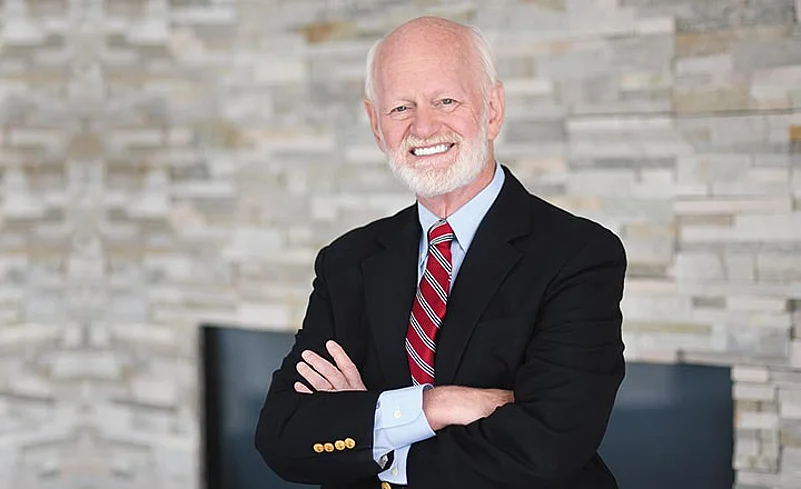New York/ August 5, 2017
Marshall Goldsmith is based out of Rancho Santa Fe, California but is in New York the morning we finally get to interview him. Crisscrossing the United States or the globe is part of a day’s work for the world’s leading executive coach. He has racked up 12 million miles and is an Executive Platinum flier on American Airlines, the very card made famous by George Clooney’s character Ryan Bingham in the movie Up in the Air. Goldsmith also had the privilege of spending a lot of time with Peter Drucker, the world’s greatest management thinker. In addition, Ex-Boeing and ex-Ford CEO Alan Mulally, Buddha and the Bhagavad Gita have greatly contributed to Goldsmith’s evolution as an executive coach. Having taught many CEOs to become effective leaders, Goldsmith is now transferring all his learning through the 100 Coaches ‘pay it forward’ project.
You have been a leadership coach for decades now. Can you summarise the classic challenges faced by successful leaders?
In my book What Got You Here Won’t Get You There, I summarise 20 major challenges of successful people. I will give you three to four. The first one is winning too much. It is very hard for smart and successful people to curb their winning instinct. Even if it is meaningful, trivial or not worth it, you want to win. It is more important at the lower levels of the organisation but as you move up, it becomes less essential. One of the greatest CEOs of all time, Alan Mulally, once said, “For a great achiever it’s all about me, for a great leader it’s all about them.” So, one has to give up this need to win constantly. One of the great lessons Peter Drucker taught me was that our mission in life is to make a positive difference. It is not to prove you are smart or you are right.
Let’s look at a case study where almost all my clients fail. Say you are going to dinner with your partner. You want to go to restaurant X, she wants to go to restaurant Y. You have an argument but you end up going to restaurant Y. It isn’t your choice, the food tastes awful and the service is terrible. Option A, you can critique the food and tell your partner that this could have been avoided by listening to you or option B you could shut up, eat the food and have a nice evening. What would I do and what should I do? Almost all my clients critique the food but agree that what they should instead do is shut up. It’s very hard for smart, successful people not to constantly win.
Problem number two is adding too much value. When employees approach you with ideas, the response usually is ‘Nice idea, why don’t you add this to it?’ The quality of the idea may improve by 5% but effective execution will reduce by 50% as now it is your idea. One of my coaching clients JP Garnier, who retired as CEO of Glaxo-SmithKline Pharma, told me that he learnt a very hard lesson once he became a chief executive. He said, “My suggestions become orders. If they’re smart, they’re orders. If they’re stupid, they’re orders. If I want them to be orders, they are orders. And, if I don’t want them to be orders, they are orders anyway.” It’s very hard for smart people to realise that when they make a suggestion, it is an order, even when they don’t mean it that way. So, CEOs should leave it at, “Thank You, great idea!”
Issue number three is passing too much judgement. It is important before passing a judgement to breathe and ask yourself if it is worth it. “Will my judgement or comment improve this person’s commitment or my relationship with this person?” If the answer is no, why am I saying it? Maybe sometimes it is worth saying but most of the time at work it is not worth it. The fourth one is the tendency of successful people to say, ‘I already knew that.’ It is incredibly difficult for successful people who already knew not to point it out.
Having outlined the classic challenges, how do you advise leaders to move in the right direction?
I coach leaders to help more and judge less. It is not that leaders never have to make judgements. The point is if you focus more on helping and less on judging, you tend to be better off. And one suggestion I teach is called ‘Feedforward’, where we focus on what can be done differently in the future to create a positive change and not dwell on the past.
Another thing I tell them is that every CEO needs to be a role model. Not only should they give feedback or ideas to people, they should also ask for the same in return. It is a way of asking “How can I be better?”. The entire process of development is a two-way street. Looking at you and saying that you need to improve is very different from saying, “I am going to try help you get better and I also want to improve myself.”
What professional and personal advice do you frequently give top leaders?
Drucker taught me that every decision in life is made by the person who is empowered to make the decision. Make peace with that. They may not be the smartest, most fair or the right person but the decision maker is your customer and you have to sell to them. Drucker says sell what you can and make peace with what you cannot sell. Change what you can and make peace with things that you cannot change.
A lot of my time is spent educating CEOs that they too have customers in the form of board of directors and owners to whom they have to sell to. Sometimes, with a job title like CEO one tends to think, they cannot tell me what to do. It is very important to recognise that at every level in the world you have to influence people.
You talked about Feedforward, how is it different from feedback?
In theory, constructive feedback is supposed to focus on the performance, not the person. In practice, almost all feedback is taken personally no matter how it is delivered. Successful people’s sense of identity is highly connected with their work. The more successful people are, the more this tends to be true. Right or wrong, feedback is associated with judgment. This can lead to very negative or even career-limiting unintended consequences when applied to managers or peers.
Feedforward doesn’t imply superiority of judgment. It has roles and rules. Role number one is learn as much as you can and number two is help as much as you can. The world is full of smart people you can learn from and nice people whom you can help. Rule number one is no feedback about the past. We spend too much time analysing the past. Rule number two is you can’t judge people’s ideas. All you should do is listen and say thank you.
In Feedforward you are supposed to treat every idea as a gift. When someone gives you a gift, you don’t say it is a stupid gift, you say thank you. If you want to use it, use it, if you don’t want to then don’t. Buddha taught us that you can only do what I teach if it works for you. If it doesn’t work for you, it is okay, just don’t do it. Feedforward is about helping each other not judging each other.
So, do you find CEOs saying thank you more often? How has the attitude towards executive coaching changed over the years?
There has been a major change over the years. One thing that I am very proud of is my book Triggers, which was endorsed by 27 major CEOs. About 30 years ago, none of the CEOs would go anywhere near an executive coach. Now, distinguished CEOs are not embarrassed to have a coach. They have realised that the right coach only makes you more effective.
How can CEOs ensure a high sense of ownership and employee engagement?
The more people take responsibility for what is happening, the better. The more a CEO demonstrates ownership, the more ownership people will have when presenting their ideas. Drucker said, “The leader of the past was a person who knew how to tell. The leader of the future will be a person who knows how to ask”.
In the past, the leader knew more than the followers. Today, most of the CEOs I work with manage knowledge workers. They tend to know more than their bosses. If you manage knowledge workers, we can’t just tell them what to do and how to do it. We have to ask, listen, learn and involve them to the degree to which we can do that. We can inspire a whole lot of ownership than just telling them what to do.
You talk about the six active questions that make one a better leader. Can you expound on its role in increasing employee engagement?
Years ago, I watched a presentation by three of the top HR leaders in the world. They talked about things like training programs, empowerment and fairness. They concluded that employee engagement globally was at an all-time low. I thought if they knew so much and we’ve been teaching the same thing for 30 years, how is it that engagement is at an all-time low? That was because 100% of the dialogue was what the company can do to engage you and 0% of how you can engage yourself. There’s where people are missing half the equation.
Then another time, I was on a typical American Airlines flight for three hours, one flight attendant was upbeat and positive and another was bitter and angry. It’s the same uniform, the same engagement programme, so what’s the difference? The difference is not what’s on the outside, it’s what’s on the inside.
So, I got my daughter, Kelly, involved in this. She graduated from Duke University and did a PhD from Yale and is a tenured professor of marketing at Vanderbilt University. She said everything on employee engagement revolves around passive questions. She pointed out that if you ask people passive questions and if they give negative answers, then they tend to blame the environment. She taught me the importance of asking active questions. Especially, questions that begin with the phrase “Did I do my best to… ?” This is one thing you can’t blame on other people. So following are the six active questions and I ask myself these every day. Question number one: Did I do my best to set clear goals? Instead of asking did the company set clear goals for me. Number two: Did I do my best to progress towards achieving my goals? Rather than asking did they help me achieve my goals. Question number three: Did I do my best to find meaning, rather than saying did they give me meaning? Number four, did I do my best to be happy rather than saying did somebody do something to make me happy? Number five, did I do my best to build positive relationships? Rather than asking do you have a best friend at work, ask were you that friend? Finally at number six, did I do my best to be fully engaged? Rather than saying did the company engage me.
These questions get us to focus not on what you cannot do, but what you can do. The idea is very consistent with something from the Bhagavad Gita. By the way, in life you cannot change the hand of cards that you’ve been dealt, all you can change is the way you play your cards. The essence of the Bhagavad Gita describes that when you are in a very tough situation, it is what it is, do your best and make the best of the situation.
Atul Gawande from Harvard wrote a great book called the Checklist Manifesto. In that book, Dr Gawande points out that if doctors run a very simple checklist before a surgery, not only do the infection rates plummet but the death rate also reduces by two-third? Most of these huge hospitals don’t allow the nurses to ask the doctor a question. The doctor is ashamed to say, “I’m a doctor and I need help”. They don’t have the courage everyday they have someone ask. So, people die. According to Dr Gawande, more people have died due to the egos of surgeons than due to the Vietnam war, Afghan war and Iraq war combined. If you don’t have this ego, life is much better.

Since ego is the biggest stumbling block for leaders, how can leaders overcome it?
I wrote the theory about how to change but I have to tell you that it is very hard to do. Once we get over all this macho ‘I can do everything on my own’ nonsense, life is much better. Leaders who get better have three qualities that differentiate them from those who don’t change. One, is courage. It takes courage to look into the mirror and take feedback, to admit that you need help to improve. And then it takes humility to improve. No one can get better if they’re perfect to start with. The third is discipline, the day-to-day tolerance required to actually change.
You talk about Alan Mulally as one leader you have learnt a lot from, what made him stand out?
Alan was the CEO of Boeing Commercial Aircraft. He did a phenomenal job under very difficult circumstances. He was the CEO during 9/11, which was a terrible situation for him. Then he became the CEO of Ford where the stock value had gone down to $1.01, and in the next four years it rose to $18.40. Not only did he produce these huge results, employees loved him and he was the most respected CEO in the United States in a union organisation.
Alan is a great example of a leader, who is not lost in his ego and I’ll tell you a couple of things that illustrate his ‘leader as facilitator’ approach. The first thing when he became the CEO of Ford was to establish clear guidelines for leadership behaviour. There was zero tolerance for bad behaviour. So he said no more destructive comments or putting people down, no using cell phones in the middle of meetings, etc. One of his direct reports didn’t like this and complained to chairman Bill Ford about this childish Boy Scout nonsense. Bill asked him to talk to Alan who said, “I made a choice you made a choice, goodbye,” when a second leader challenged him, same outcome. Fourteen of the 16 people, who led the company into bankruptcy, were the same people who turned the company around.
When he was at Boeing, he was very tough about zero tolerance because in airplanes you cannot tolerate defects, there should be zero defects. So, he applied that to bad behaviour. Another thing he did was using the ‘red, yellow or green system’ for top leaders and their key objectives. Green meant I’m on plan, yellow meant I’m not on plan but I have a strategy to get there and red was for I’m not on plan and I have no strategy. During the first review meeting, everybody seemed to be green. So Alan said the finance department says we might lose $17 billion this year but everyone is on plan. Can I get the plan to lose $17 billion from whoever’s willing? Finally, someone said red and Alan applauded him and added, “Thank you for having the courage to say red. If you don’t have a plan and don’t know how to get there, it is okay. As the CEO of your company, I know less about your problem than you do but we can find people who can help us solve the problem.” Alan never jumped in with a solution or demanded one from his team during meetings. Alan’s attitude is, “If I’m not the world’s expert on this topic, why am I talking?’ He always used to ask during meetings, who in the room can help or know someone that can help. That created an environment, where people could talk openly about their issues or concerns, and they no longer hid their problems.
You also mention General Shinseki and Frances Hesselbein as being great leaders. What was unique about their approach?
General Shinseki is a great human being. He stood up against Donald Rumsfeld and said you not only killed a lot of troops but cost us a lot of money and he was publicly crucified for telling the truth. So, he was a great leader, who leads by example. It turned out later that he had challenges when he was the leader of Veteran Affairs, where he trusted people who turned out later to be not so trustworthy.
My friend, Frances, she was with Girl Scouts America and managed a fantastic turnaround of the organisation. She practised something which I’ve never seen in another leader, it’s called “servant leadership”. I’ll give you an example, when she was with the Girl Scouts, she called me and asked if I could teach a leadership training class for her top leaders in New York and Chicago. I said that the only day I was available was a Saturday, which she agreed to. I was embarrassed to admit to her that since I was on the road everyday, I had to get my laundry done sometime. I asked if it was possible to get my laundry done. She said, “Not a problem. Just pile your laundry on the floor, we will have someone pick it up and we’ll get your laundry done. It will be done by the end of the program”. So, I take all my dirty shirts, clothes, underwear and pile them up on the floor. And next morning I’m having breakfast with the head of the Girl Scouts from the big cities. I look up and walking across the hall is Frances Hesselbein, carrying my dirty laundry to the laundromat. And she was the CEO, every woman saw her carry the laundry. To me that was one of the most powerful leadership moments I’ve ever seen. Not leadership through talking but leadership through living.
Any other great leaders you’ve interacted with that come to mind?
Yes, one leader I coach right now is Hubert Joly, he is the CEO of Best Buy and like Alan, he faced an organisation that was in critical trouble and he’s done a fantastic job of turning the organisation around. Liz Smith was the former president at Avon and now runs Bloomin’ Brands. I have had the privilege of working with many great leaders. One reason that they are so effective in leading people is that they are always trying to improve themselves — not just asking everyone else to improve.
If you look at Alan Mulally, he’s a great example. Every leader is responsible to be a team member as well. So not only are you a leader but you’re a team member and you have to make sure that everyone is focused on your goal, but being a great team member helping others. And also at this level everyone should be a knowledge worker. If I’m the CEO and I know more about marketing than the marketing person, more about HR than the HR person, more about finance than the finance person; I don’t have a leadership problem, I have a selection problem. I’ve picked the wrong team. So, my job is that of a facilitator, who co-ordinates his team’s efforts not someone who just passes orders.
You also talked about the Bhagavad Gita. Can you tell us how you got acquainted with it and how you use its principles in your coaching?
I’m a philosophical Buddhist and I have spent years studying different religious philosophies. I look at the Bhagavad Gita as a great way for leaders to learn. One of the lessons I use from it for my coaching is, don’t focus on the past, focus on where you are and how I can do my best right now. Which is all any of us can ever do. The Bhagavad Gita says don’t become attached to the fruits of your labour. Focus on the process. That doesn’t mean you shouldn’t set goals. It only means that you don’t become attached to the achievement of those goals. You only focus on the day-to-day process, how can I be the best that I could be everyday?
What the Bhagavad Gita encourages people to do is take the responsibility for what you can do. Don’t become paralysed or immobilised by what you cannot do. The Bhagavad Gita says that life is not fair, it is what it is, suck it up, do your best. So, that’s something I teach leaders all the time. Sometimes, even the leaders I coach will whine or complain. I ask them have you ever seen a Broadway play where the actors stand up and say my foot hurts? My aunt died last week? I had a headache? No, it’s showtime. Well, to me that’s what the Bhagavad Gita says. You don’t whine or complain or blame others, do your best. It’s a great way to not only look at leadership but life.
Another thing I teach in my book Triggers is the ‘Wheel of Change’, which has two dimensions. One dimension is negative and positive and the other dimension is change and keep. So, there are four quadrants, the fourth quadrant is called creating i.e. a positive change. The second quadrant is called preserving and that’s positive keep. Now, creating is for example, who is the new person I want to become. Preserving is what is it about my past that I want to protect, preserve, maintain or keep. I’m here in New York City and many people here are creating wealth. They are forgetting to preserve their health, their friends, family members and sometimes what you fail to preserve is more important than what you create.
Creating is important but preserving is also important. There is another quadrant called Eliminate, what do I need to get rid of? Because if you just focus on creating and preserving without eliminating then you become over-committed. Your hands become full, we can’t do it all. In order to effectively create, we need to eliminate. The fourth one is called accepting, you may say why do I need to keep something negative? Sometimes in life we just need to learn to accept things you can’t change. So you look at this philosophy of creating — Brahma, preserving — Vishnu and eliminating — Shiva and then effectively being more like Buddha. So, I have been influenced by Indian philosophy.
What would be the right way to evaluate a leader’s legacy?
A leader should facilitate a better life for his followers and they in turn should help the people around them have a better life. I went to this program sponsored/run by Ayse Birsel, who wrote a book called Design The Life You Love. In the program she asks people to write down their heroes and why they inspire them. My heroes turned out to be teachers such as Buddha, Peter Drucker, Frances Hesselbein, Paul Hersey and Alan Mulally, who were very generous people and always helped me for free. Then you get asked, why don’t you try to be more like your heroes? So, I decided to teach 15 people all I know for free under the 15 Coaches program, which I extended to 100 as I got 12,000 distinguished applicants for the 15 positions.
As for a leader’s legacy, this is what I ask every leader to do. Take a deep breath, imagine you’re 95-years-old and you’re getting ready to die. Before you take your final breath you get your beautiful gift: The ability to go back in time and talk to yourself in your present state. And what advice would the wise 95-year-old you give about what matters in life and doesn’t? In terms of performance appraisal, that’s the only one that will matter.
So friends of mine interviewed old friends of theirs who were dying by asking them these questions — what advice would you have? On the personal side, three things, number one — be happy now. Not next week, not next month, not next year, be happy now. The great western disease is I’ll be happy when… India, unfortunately, is inflicted with this disease of I’ll be happy when I get the money, the status, the BMW; as opposed to focusing on being happy now. Number two, family and friends. When you’re on your deathbed, not many of your co-workers will be there waving goodbye and number three, if you have a dream, then go for it. Because if you do not go for it when you’re 35, you’re not going to go for it when you’re 45 or 55. If other people think your dream is goofy, who cares. It’s not their dream, it’s your dream. It’s not their life, it is your life.
Business advice ain’t much different, number one, life is short, have fun. Number two, do whatever you can do to help people and how you help people has nothing to do with money or status. The main reason you help people is because the 95-year-old you is going to be proud that you did so and will be disappointed if you didn’t. Number three, the industry is changing, you may not win but atleast you tried. Old people almost never regret their failures; they only regret the risk they failed to take.






























